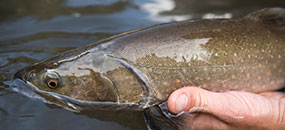Students from Marine Park Intermediate School in Brooklyn
By Chris Wood
Lilli Genovesi is in the eye of the hurricane. How else could she—with her awesome partners at the New York Dept. of Environmental Protection, the Dept. of Environmental Conservation and local TU chapters—manage over 250 schools in the southern New York area that participate in Trout in the Classroom with such aplomb? Lilli is quick to talk about how Trout in the Classroom is an amazing STEM (Science, Technology, Engineering, and Math) approach to learning, but my favorite Trout in the Classroom story is one Lilli asks me not to tell.
Most of these kids know little about nature and a lot less about trout. They watch trout eggs turn into alevins with their yolk sacs attached before emerging as fry. After learning about the hydrologic cycle and rearing their fish, the students take a school bus to the Cross River at Ward Pound Ridge Reservation to release their baby trout.
Lilli explains what happens next. “The larger wild fish in the river are acclimated to our releases, so every day at 10am, they swim downstream and wait for these kids with their Dixie cups to kneel by the river and release their “friends.” One parent memorably screamed, “Ohmigosh, that bully trout ate Johnny’s baby!” as a big brown gulped his snack. Apparently, the skwala hatch in Montana has nothing on the emergence of the yellow school bus hatch on the Cross River in New York.
Since the late Joan Stoliar began the program with help of volunteers from TU and the Theodore Gordon Fly Fishers, Trout in the Classroom has expanded to hundreds of schools around the country. Very conservatively, well more than 100,000 kids are involved in the program.
One of my favorite memories at TU is from a trout release for one of the Maryland schools. About 90 schools participate in Trout in the Classroom with TU and the Maryland DNR. We were at a local park, and these Baltimore kids were having a hoot—learning to cast, tromping around the water, identifying bugs—just being kids in nature. It came time to release the trout, and I ended up spending 10 minutes consoling (after checking for rogue brown trout) Tamika that “Larry,” her released trout, would be happy in the river.
Bob Wible of the Central Vermont chapter says it well. “All I see is happy teachers and happy students.”
In Minnesota, the students monitor stream temperature and survey macroinvertebrates to see if rivers will support trout. Eighth grade science teacher, Lauren Reuss says, the kids are “able to make their own flies and see how that relates to the structure of all of these macroinvertebrates. It’s kind of like arts and crafts and science all wrapped into one. “
It is difficult to overstate the importance of the teachers. Their willingness to take on additional work, learn and teach a new curriculum, and make sure the trout are cared for is remarkable. It should warm even the cynic’s heart to know that in New York over 200 teachers—half of whom are new—participate in two annual trainings held by Lilli Genovesi and her partners.
Franklin Tate directs our youth education programs. I first heard Franklin Tate speak at an education conference 10 years ago. I leaned over and said to a TU colleague, “We have to hire this guy.” Franklin developed the genius concept of “the stream of engagement,” where TU tries to influence kids to become outdoor-stewards from Kindergarten through college.
Franklin says, “If a teacher tries to explain how gills process dissolved oxygen to a fish’s blood and cells, a student’s eyes will glaze. Describe the same thing with a live trout, and the kid can’t get enough. That is the power of Trout in the Classroom, it makes science and conservation so much more experiential, so much more real.”
Providing the tangible connection to nature at a young age makes it much more likely that these kids will stay the course, and perhaps attend a TU youth camp. Maybe they will get involved in a Five Rivers program in college. Maybe someday they will become a chapter leader.
Trout in the Classroom, the entire stream of engagement, is reminiscent of the old adage: These are not our lands and waters. We have borrowed them from our children. The least we can do is to help them take care of them.
Chris Wood is the president and CEO of Trout Unlimited.






